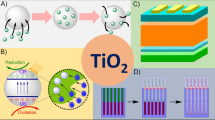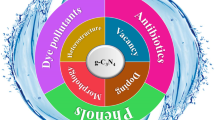Abstract
Titanium dioxide was modified with Pt–polypyrrole nanocomposites through the in situ simultaneous reduction of Pt(iv) and the oxidative polymerization of pyrrole monomers at ambient temperature. The modified powders were characterized using X-ray photoelectron spectroscopy (XPS), dark-field scanning transmission electron microscopy (DF-STEM), infrared spectroscopy (IR) and by the determination of the BET surface area by nitrogen adsorption. Photocatalytic hydrogen production tests were performed employing 75 ml aqueous solution containing 2250 μmol methanol as the sacrificial electron donor. The obtained results show that 0.5 and 1.0 wt% Pt and polypyrrole, respectively, are the optimum ratios for high photocatalytic H2 production rates. The amount of H2 evolved during 5 h of UV-vis illumination of the suspension of Pt–polypyrrole modified TiO2 powder is three times higher than that obtained with Pt-loaded TiO2 prepared by a photochemical deposition method. The photonic efficiencies of the H2 production employing 75 ml aqueous solution containing 370 mmol methanol were calculated to be 10.6 ± 0.5 and 4.5 ± 0.2% for TiO2 modified with Pt–polypyrrole nanocomposites and for Pt-loaded TiO2 prepared by a photochemical deposition method, respectively. A synergistic effect between Ptnanoparticles and polypyrrole leading to a better separation of the charge carriers is proposed to explain the enhanced reactivity of the newly synthesized photocatalyst.
Similar content being viewed by others
References
J. R. Rostrup-Nielsen, Fuels and energy for the future: the role of catalysis, Catal. Rev., 2004, 46, 247–270.
W. W. Clark, II, and J. Rifkin, A green hydrogen economy, Energy Policy, 2006, 34, 2630–2639.
K. Maeda, and K. Domen, New non-oxide photocatalysts designed for overall water splitting under visible light, J. Phys. Chem. C, 2007, 111, 7851–7861.
A. Galińska, and J. Walendziewski, Photocatalytic water Splitting over Pt-TiO2 in the presence of sacrificial reagents, Energy Fuels, 2005, 19, 1143–1147.
M. Kitano, K. Iyatani, K. Tsujimaru, M. Matsuoka, M. Takeuchi, M. Ueshima, J. M. Thomas, and M. Anpo, The effect of chemical etching by HF solution on the photocatalytic activity of visible Light-responsive TiO2 thin films for solar water splitting, Top. Catal., 2008, 49, 24–31.
C. N. Hamelinck, A. P. C. Faaij, Future prospects for production of methanol and hydrogen from biomass, J. Power Sources, 2002, 111, 1–22.
M. Park, and M. Kang, The preparation of the anatase and rutile forms of Ag–TiO2 and hydrogen production from methanol/water decomposition, Mater. Lett., 2008, 62, 183–187.
G. Wu, T. Chena, W. Su, G. Zhou, X. Zong, Z. Lei, and C. Li, H2production with ultra-low CO selectivity via photocatalytic reforming of methanol on Au/TiO2catalyst, Int. J. Hydrogen Energy, 2008, 33, 1243–1251.
M. R. Hoffmann, S. T. Martin, W. Choi, and D. W. Bahnemann, Environmental applications of semiconductor photocatalysis, Chem. Rev., 1995, 95, 69–96.
D. Bahnemann, A. Henglein, J. Lilie, and L. Spanhel, Flash photolysis observation of the absorption spectra of trapped positive holes and electrons in colloidal TiO2, J. Phys. Chem., 1984, 88, 709–711.
D. Bahnemann, A. Henglein, and L. Spanhel, Detection of the intermediates of colloidal TiO2-catalysed photoreactions, Faraday Discuss. Chem. Soc., 1984, 78, 151–163.
C. Wang, R. Pagel, D. W. Bahnemann, and J. K. Dohrmann, Quantum yield of formaldehyde formation in the presence of colloidal TiO2-based photocatalysts: effect of intermittent illumination, platinization, and deoxygenation, J. Phys. Chem. B, 2004, 108, 14082–14092.
J. Kiwi, M. Grätzel, Optimization of conditions for photochemical water cleavage. aqueous platinum/TiO2 (anatase) dispersions under ultraviolet light, J. Phys. Chem., 1984, 88, 1302–1307.
H. Park, and W. Choi, Photocatalytic reactivities of nafion-coated TiO2 for the degradation of charged organic compounds under UV or visible light, J. Phys. Chem. B, 2005, 109, 11667–11674.
M. S. Vohra, and K. Tanaka, Enhanced photocatalytic activity of nafion-coated TiO2, Environ. Sci. Technol., 2001, 35, 411–415.
D. Chowdhury, A. Paul, and A. Chattopadhyay, Photocatalytic polypyrrole-TiO2-nanoparticles composite thin film generated at the air-water interface, Langmuir, 2005, 21, 4123–4128.
D. Wang, Y. Wang, X. Li, Q. Luo, J. An, and J. Yue, Sunlight photocatalytic activity of polypyrrole–TiO2 nanocomposites prepared by ‘in situ’ method, Catal. Commun., 2008, 9, 1162–1166.
H. Park, and W. Choi, Visible-light-sensitized production of hydrogen using perfluorosulfonate polymer-coated TiO2 nanoparticles: An alternative approach to sensitizer anchoring, Langmuir, 2006, 22, 2906–2911.
R. J. Noufi, The incorporation of ruthenium oxide in polypyrrole films and the subsequent photooxidation of water at n-GaP photoelectrode, J. Electrochem. Soc., 1983, 130, 2126–2128.
A. J. Frank, and K. Honda, Polymer-modified electrodes, catalysis and water splitting reactions, J. Photochem., 1985, 29, 195–204.
G. Cooper, R. Noufi, A. J. Frank, and A. J. Nozik, Oxygen evolution on tantalum-polypyrrole-platinum anodes, Nature, 1982, 295, 578–580.
A. Yildiz, A. Sobczynski, A. J. Bard, A. Campion, M. A. Fox, T. E. Mallouk, S. E. Webber, and J. M. White, Sensitized polypyrrole-coated semiconducting powders as materials in photosystems for hydrogen generation, Langmuir, 1989, 5, 148–149.
R. Abe, K. Sayama, and H. Sugihara, Development of new photocatalytic water splitting into H2 and O2 using two different semiconductor photocatalysts and a shuttle redox mediator IO3−/I−, J. Phys. Chem. B, 2005, 109, 16052–16061.
P. R. Moses, L. M. Wier, J. C. Lennox, H. O. Finklea, J. R. Lenhard, and R. W. Murray, X-ray photoelectron spectroscopy of alkylamine-silanes bound to metal oxide electrodes, Anal. Chem., 1978, 50, 576–585.
C. G. Hatchard, and C. A. Parker, A new sensitive chemical actinometer. II. Potassium, ferrioxalate as a standard chemical actinometer, Proc. R. Soc. Ser. A, 1956, 235, 518–536.
T. Nash, The colorimetric estimation of formaldehyde by means of the Hantzsch reaction, Biochemistry, 1953, 55, 416–421.
C. Kormann, D. W. Bahnemann, and M. R. Hoffmann, Photocatalytic production of H2O2 and organic peroxides in aqueous suspensions of TiO2, ZnO2 and desert sand, Environ. Sci. Technol., 1988, 22, 798–806.
M. Zhao, and R. M. Crooks, Dendrimer-encapsulated Pt nanoparticles: synthesis, characterization, and applications to catalysis, Adv. Mater., 1999, 11, 217–220.
H. Yang, T. Lu, K. Xue, S. Sun, G. Lu, and S. Chen, Electrocatalytic oxidation of methanol on polypyrrole film modified with platinum microparticles, J. Electrochem. Soc., 1997, 144, 2302–2307.
S. Tamil Selvan, J. P. Spatz, H. Klok, Martin Möller, Gold-polypyrrole core-shell particles in diblock copolymer micelles, Adv. Mater., 1998, 10, 132–134.
B. Tian, and G. Yerbi, Lattice dynamics and vibrational specra of polypyrrole, J. Chem. Phys., 1990, 92, 3886–3891.
M. A. Fox, and K. L. Worthen, Comparison of the physical properties of polypyrrole produced by anodic oxidation and by photoelectrochemical activation of TiO2, Chem. Mater., 1991, 3, 253–257.
S. Deki, H. Nishikawa, and M. Mizuhata, Fabrication of Pt nanoparticles-polypyrrole composite for electrocatalyst, Electrochemistry, 2004, 75, 415–417.
J. Cheni, D. F. Ollis, W. H. Rulkens, and H. Bruning, Photocatalyzed oxidation of alcohols and organochlorides in the presence of native TiO2 and metallized TiO2 suspensions. Part(II): Photocatalytic mechanisms, Water Res., 1999, 33, 669–676.
C. Wang, J. Rabani, D. W. Bahnemann, and J. K. Dohrmann, Photonic efficiency and quantum yield of formaldehyde formation from methanol in the presence of various TiO2 photocatalysts, J. Photochem. Photobiol. A, 2002, 148, 171–176.
R. Gao, J. Stark, D. W. Bahnemann, and J. Rabani, Quantum yields of hydroxyl radicals in illuminated TiO2 nanocrystallite layers, J. Photochem. Photobiol. A, 2002, 148, 387–391.
J. Marugan, D. Hufschmidt, M. J. Lopez-Munoz, V. Selzer, and D. Bahnemann, Photonic efficiency for methanol photooxidation and hydroxyl radical generation on silica-supported TiO2 photocatalysts, Appl. Catal., B, 2006, 62, 201–207.
K. D. Asmus, H. Moeckel, and A. Henglein, Pulse radiolytic study of the site of hydroxyl radical attack on aliphatic alcohols in aqueous solution, J. Phys. Chem., 1973, 77, 1218–1221.
C. von Sonntag, Free-radical-induced DNA damage and its repair. A chemical perspective.Springer-Verlag: Berlin, Heidelberg, New York, 2006, Chapter 7.
Y. Nosaka, H. Sasaki, K. Norimatsu, and H. Miyama, Effect of surface compound formation on the photo-induced reaction at polycrystalline TiO2 semiconductor electrodes, Chem. Phys. Lett., 1984, 105, 456–458.
N. Hykaway, W. M. Sears, H. Morisaki, and S. R. Morrison, Current-doubling reactions on titanium dioxide photoanodes, J. Phys. Chem., 1986, 90, 6663–6667.
R. Memming, Top. Curr. Chem., 1994, 169, 105–181.
G. Nogami, and J. H. Kennedy, Investigation of current doubling mechanisms of organic compounds by the rotating disk electrode technique, J. Electrochem. Soc., 1989, 136, 2583–2588.
L. D. Burke, W. A. O’Leary, Electro-oxidation of formaldehyde at silver anodes–Role of submonolayer hydroxy complexes in noble metal electrocatalysis, J. Electrochem. Soc., 1988, 135, 1965–1970.
W. Y. Teoh, L. Maedler, and A. Rose, Inter-relationship between Pt oxidation states on TiO2 and the photocatalytic mineralization of organic matters., J. Catal., 2007, 251, 271–280.
T. L. Villarreal, R. Gomez, M. Neumann-Spallart, N. Alonso-Vante, and P. Salvador, Semiconductor photooxidation of pollutants dissolved in water: A kinetic model for distinguishing between direct and indirect interfacial hole transfer. I. Photoelectrochemical, experiments with polycrystalline anatase electrodes under current doubling and absence of recombination, J. Phys. Chem. B, 2004, 108, 15172–15181.
P. Herrasti, and L. Peter, Photocurrent doubling during the oxidation of formic acid at n-CdS: an investigation by intensity modulated photocurrent spectroscopy, J. Electroanal. Chem., 1991, 305, 241–258.
Y. Maeda, A. Fujishima, and K. Honda, The investigation of current doubling reactions on semiconductor photoelectrodes by temperature change measurements, J. Electrochem. Soc., 1981, 128, 1731–1734.
K. Micka, and H. Gerischer, Anodic photooxidation of formic acid and methanol at a zinc oxide electrode and the influence of anions., J. Electroanal. Chem. Interfac. Eectrochem., 1972, 38, 397–402.
T. Abe, E. Suzuki, K. Nagoshi, K. Miyashita, and M. Kaneko, Electron source in photoinduced hydrogen production on Pt-supported TiO2 particles, J. Phys. Chem. B, 1999, 103, 1119–1123.
D. W. Bahnemann, M. R. Hoffmann, A. P. Hong, and C. Kormann, in The chemistry of acid rain sources and atmospheric processes, ACS Symp. Ser. 349, R. W. Johnson, and G. E. Gordon, eds., Washington, DC, 1987, Chapter 10, 120–132.
Author information
Authors and Affiliations
Corresponding author
Additional information
This paper was published as part of the themed issue of contributions from the 5th European Meeting on Solar Chemistry and Photocatalysis: Environmental Applications held in Palermo, Italy, October 2008.
Rights and permissions
About this article
Cite this article
Kandiel, T.A., Dillert, R. & Bahnemann, D.W. Enhanced photocatalytic production of molecular hydrogen on TiO2 modified with Pt–polypyrrole nanocomposites. Photochem Photobiol Sci 8, 683–690 (2009). https://doi.org/10.1039/b817456c
Received:
Accepted:
Published:
Issue Date:
DOI: https://doi.org/10.1039/b817456c




